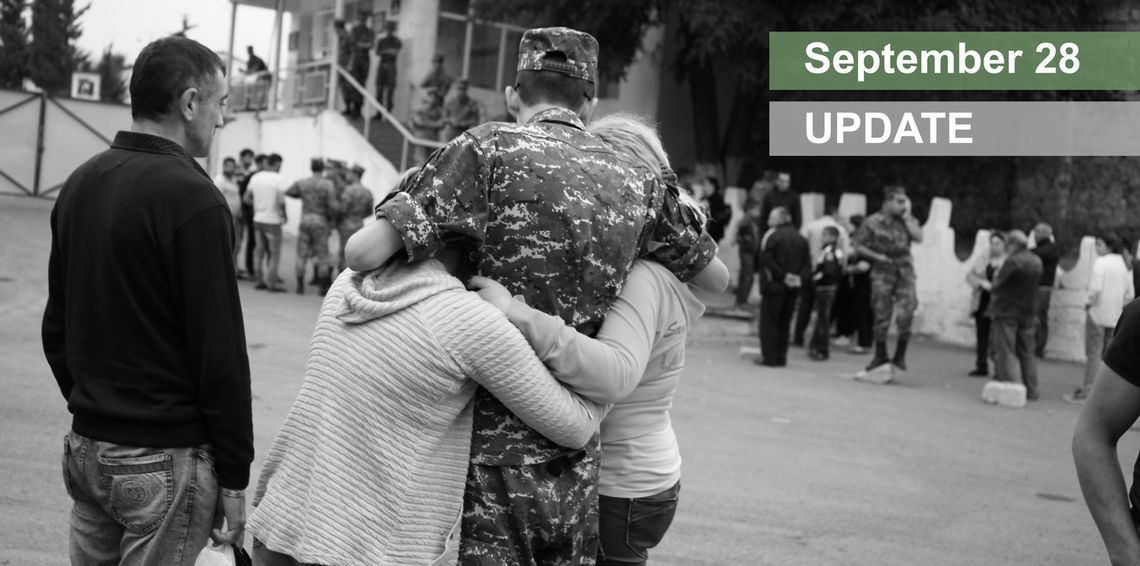EVN Report - 28/09
Fighting continued on Monday, September 28, 2020 along the full length of the Line of Contact between Artsakh and Azerbaijan, after the launch of an assault by Azerbaijan the previous day that has been unprecedented, even when compared to the Four Day April War of 2016.
The regions of Martakert and Hadrut in particular have remained under continuous artillery assaults, while Artsakh Defense Army forces were able to recover previous advances by Azerbaijani troops. According to the latest official update, Armenian troops have suffered 58 casualties, some of them as young as 18 years old.
The Line of Contact is subject to a ceasefire agreement reached in 1994, which left Nagorno-Karabakh, now officially the Republic of Artsakh, with a de facto independence pending a lasting settlement at the negotiation table. While that ceasefire has been violated sporadically over the past 26 years, the latest Azerbaijani offensive is no minor skirmish. The most salient factor this time is the direct involvement of Turkey.
Although Turkey has always supported Azerbaijan in the conflict, most notably by imposing a blockade along its eastern border with Armenia, in the past, it tried to maintain some semblance of a fair dealer, as it sought to play a more prominent role as a mediator in the conflict and ongoing negotiations, alongside the OSCE Minsk Group Co-Chairs the United States, France and Russia. However, after tensions flared up into artillery barrages between the internationally-recognized Armenia-Azerbaijan border in July, Turkey has gone all in to support Turkic-speaking Azerbaijan. Armenian officials accuse Turkey of actively planning and assisting Azerbaijan in its latest offensive. Though the reports are unconfirmed, Turkey has been accused of transporting mercenaries from Syria, ostensibly members of terrorist groups, to Azerbaijan to take part in the offensive and its F-16s have been observed providing air support.
While Azerbaijan has attempted to cast its attack as a retaliation, it is abundantly clear that it had premeditated the operation. Following joint military drills with Turkey over the summer, Azerbaijani officials had begun commandeering civilian pickup trucks on September 22 under military mobilization powers. U.S. officials may have also been tipped off about the impending hostilities. The U.S. embassy in Baku had advised U.S. citizens not to travel beyond the greater Baku area on September 25, just two days before the attack on September 27. The U.S. embassy in Yerevan also issued a similar alert the same day urging U.S. citizens to avoid travel near the line of contact and the border, including the area north of the Dilijan National Park, up to the border with Georgia in Tavush region and to not travel to Nagorno-Karabakh. Most notably, Azerbaijan had recently criticized the impasse at the negotiation table and rejected Armenia’s calls for the installation of gunfire locators that would positively identify the instigator of any future ceasefire violations.
More likely, Azerbaijan sees the attack as retaliation for its setbacks in July on the border with Tavush, during which it lost a strategic outpost. As an authoritarian ruler, the loss hit at the legitimacy of Azerbaijani President Ilham Aliyev. He was quick to find scapegoats, sacking his long-time Foreign Affairs Minister Elmar Mammadyarov and arresting several diplomats on corruption charges. He also highlighted waste in the state run oil company and announced plans to privatize it. Highlighting internal corruption is a risky move, though.
The Aliyev family featured prominently in several international-scale corruption exposes, including the Panama Papers and the Azerbaijani Laundromat. His family retains stakes in several large businesses and has monopolized political power. Ilham Aliyev succeeded his father Heydar Aliyev as President in 2003 and installed his wife Mehriban Aliyeva as Vice President in 2017.
Armenia is no stranger to corruption itself. Following the Velvet Revolution of 2018 and the change in government, revelations about embezzled military supplies impacting the Armenian Army’s combat-readiness during the 2016 Four Day April War were met with outrage. One particularly high-profile criminal proceeding was launched against General Manvel Grigoryan, a former MP with Serzh Sargsyan’s Republican Party of Armenia. Among other materiel, rations as basic as canned meat marked “Not For Sale - Soldier’s Ration” had been found at his home.
Widespread perception of corruption, compounded by some territorial losses in 2016, played a role in the public outcry for Serzh Sargsyan’s resignation in 2018. Despite greater military spending by Azerbaijan, if Armenia and Artsakh have been successful in employing their resources more efficiently, it will provide an important advantage. Further losses by Azerbaijan could put Aliyev’s leadership in jeopardy, especially after economic problems caused by a global oil price collapse and the COVID-19 pandemic.
As the stakes are raised, there is a potential for the conflict to spill over into the wider region. With Turkey’s new bellicose rhetoric and direct involvement, Armenian Prime Minister Nikol Pashinyan has called on the international community to rein in Erdogan.
If Turkey were to take a drastic step like bombing or invading the Republic of Armenia, Armenia would call upon its CSTO ally Russia, which operates military and air bases in Armenia, to come to its defense, bringing Russia in conflict with a NATO member, which could evoke Article 5 of the NATO treaty which spells out that an attack against one member is an attack against all. While Erdogan’s abrasiveness against its NATO allies in Syria and the eastern Mediterranean now casts doubt about whether he would be able to attract their sympathies, that is a nightmare scenario that cooler heads must ensure remains only an academic thought exercise.
 Français
Français  Nederlands
Nederlands  Հայերեն
Հայերեն 

